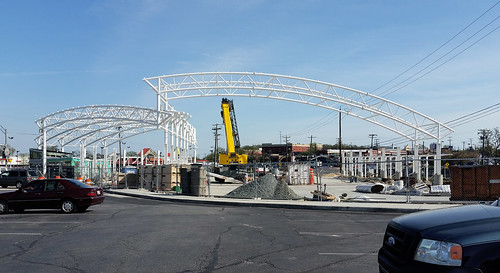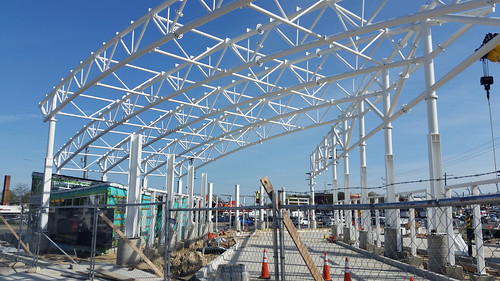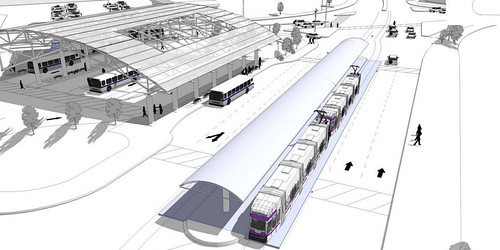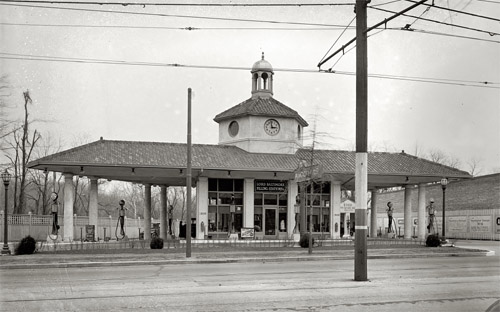
Image from Imgur user crunchtooth.
Can anyone definitively say the gunfight at the OK corral wasn’t to settle a zoning dispute over pop-up condos?
 Cross-posted at Greater Greater Washington.
Cross-posted at Greater Greater Washington.
|
|
Blog
 Image from Imgur user crunchtooth. Can anyone definitively say the gunfight at the OK corral wasn’t to settle a zoning dispute over pop-up condos? Average Rating: 4.8 out of 5 based on 291 user reviews.
 Construction is progressing rapidly at Maryland’s Takoma Langley transit center. Take a look:
 Construction progress as of Saturday, April 18, 2015. The transit center will feature bus bays and rider amenities, covered under a great curving roof that’s sure to become a local landmark.
 Fow now, the bright white frame looks more like something out of a sci-fi movie than a bus station.
 Here’s what it will all look like once construction is done:
 Rendering of the final station. Image from the State of Maryland. Langley Park needs this Langley Park, at the corner of University Boulevard and New Hampshire Avenue, is the busiest bus transfer location in the Washington region that isn’t connected to a Metro station. Eleven bus routes stop on the side of the street at the busy crossroads, serving 12, 000 daily bus riders. That’s nearly as many bus riders per day as there are Metrorail riders at Silver Spring Metro, and it’s about double the number of Metrorail riders at Takoma station. Corralling all those bus stops into a single transit center will make transfers vastly easier, faster, and safer for bus riders. Heavy construction began at the transit center last year, and is scheduled to be complete around December 2015. If the Purple Line light rail is built, Takoma Langley will become one of its stations, boosting ridership even more. The light rail transitway and station would have to be added later, and would fit snuggly in the median of University Boulevard.
 How a Purple Line station would fit. Rendering from the State of Maryland. Average Rating: 4.9 out of 5 based on 244 user reviews.
April 22nd, 2015 | Permalink
 Using a consistent apples-to-apples counting method, Demographia ranked the world’s major urban areas by population. With nearly 38 million residents, Tokyo is by far the world’s largest, and is nearly twice the size of New York’s 21 million. DC clocks in with about 5 million, good for 77th in the world.
 Tokyo is the world’s largest city. Photo from reddit user panic_switch. Cities are hard to measure It’s actually quite difficult to compare urban populations on any kind of consistent basis. City populations that follow municipal boundaries are arbitrary and inconsistent—some cities include their suburbs, while others do not. Metropolitan areas are likewise difficult to nail down. In the US, the Census defines metro areas based on county boundaries, resulting in huge geographic disparities, especially in the west where some counties are the size of eastern states. Other countries use totally different methods. Generally, the only way to build an apples-to-apples comparison is to map out the continuous built-up area of a region, and then measure the population within that area. With good enough data and consistent cut-off points, meaningful comparisons are possible. That’s called an urban area, and enough countries publish data on them that it’s possible to build a reasonably consistent world list. Demographia did the leg work of stapling together government population data from countries around the world to build this list. Demographia is owned by famous sprawl proponent Wendell Cox, and pushes a generally pro-car/anti-transit ideology. But numbers are numbers, and these are interesting numbers. The ranking Demographia’s complete list covers every urban area in the world with a population above 500, 000. It’s about 1, 000 cities long. Tokyo tops the list with almost 38 million people. Jakarta is second with about 30 million. Delhi, Manila, and Seoul round out the top five. New York has 21 million and is the largest urban area outside of Asia, good for 9th worldwide. Los Angeles has 15 million and is 18th. Paris is 29th. London is 32nd. In Maryland and Virginia, Baltimore is 206th with 2.3 million, Norfolk/Virginia Beach is 336th with 1.5 million, and Richmond is 485th with about 1 million. What surprises you? What stands out? Click over to the GGW comments, and let us know. Average Rating: 4.8 out of 5 based on 207 user reviews.
April 20th, 2015 | Permalink
 Most gas stations these days are pretty garish, but gas stations weren’t always so. Check out this vintage 1924 station, from Connecticut Avenue in Woodley Park.
 Lord Baltimore Filling Station. Photo by the National Photo Company, via the Library of Congress. This is the Lord Baltimore Filling Station, at the corner of Connecticut Avenue and Ordway Street NW. It may not be truly typical of the era, but it’s hard to imagine seeing as sharp-looking a gas station today. It’s not only the nice architecture that make this notable. It’s also the urban design. This isn’t as great for sidewalk life as a row of main street-style shops, but it’s a building that fronts on the sidewalk. It could be a lot worse. Do you know of any unusually good-looking gas stations? What makes them interesting? Average Rating: 5 out of 5 based on 228 user reviews.
April 6th, 2015 | Permalink
 |
Media Tweets by @beyonddc
Follow @beyonddc
Site
Partners
|
|||||||||||||||||||||||||
|